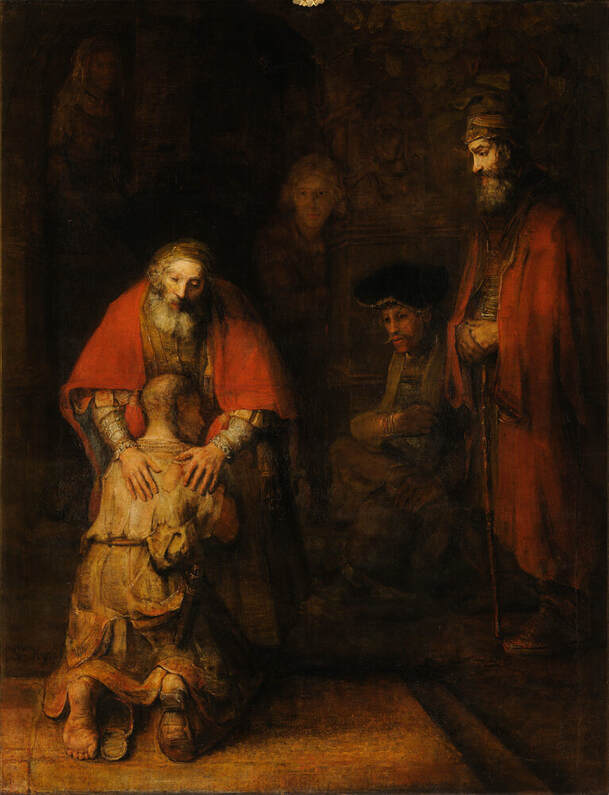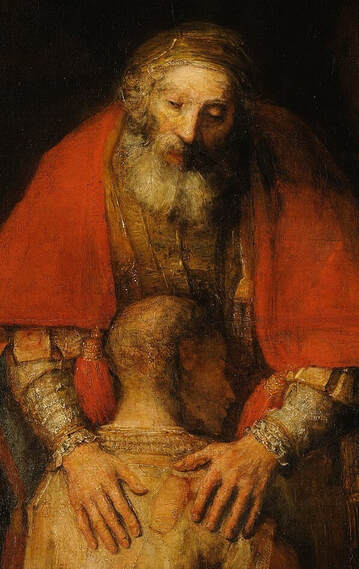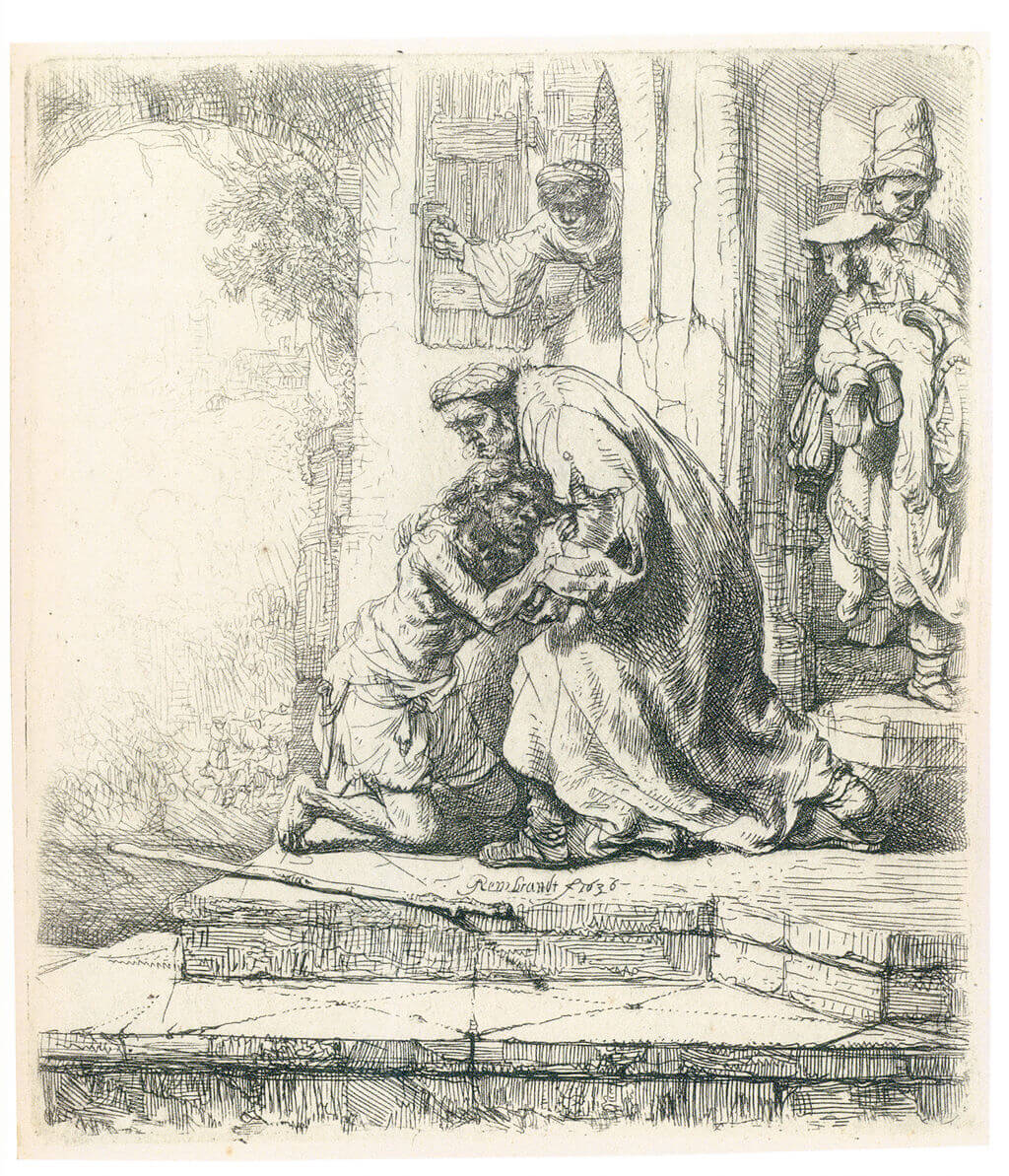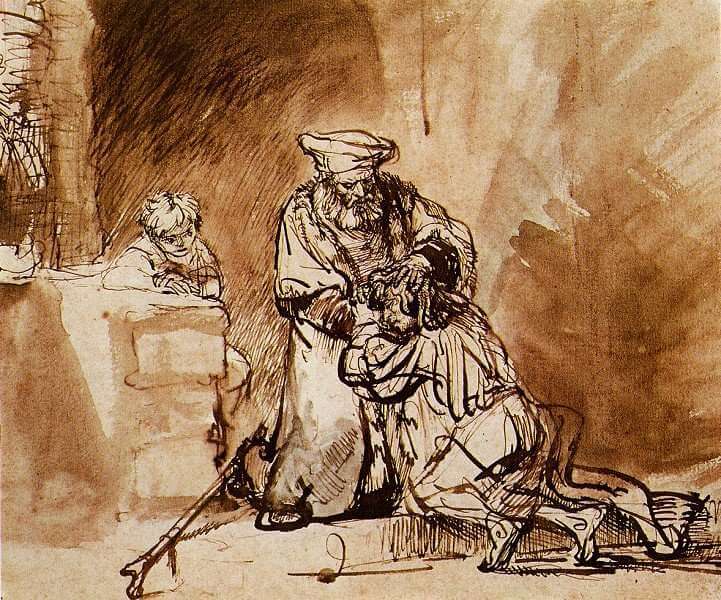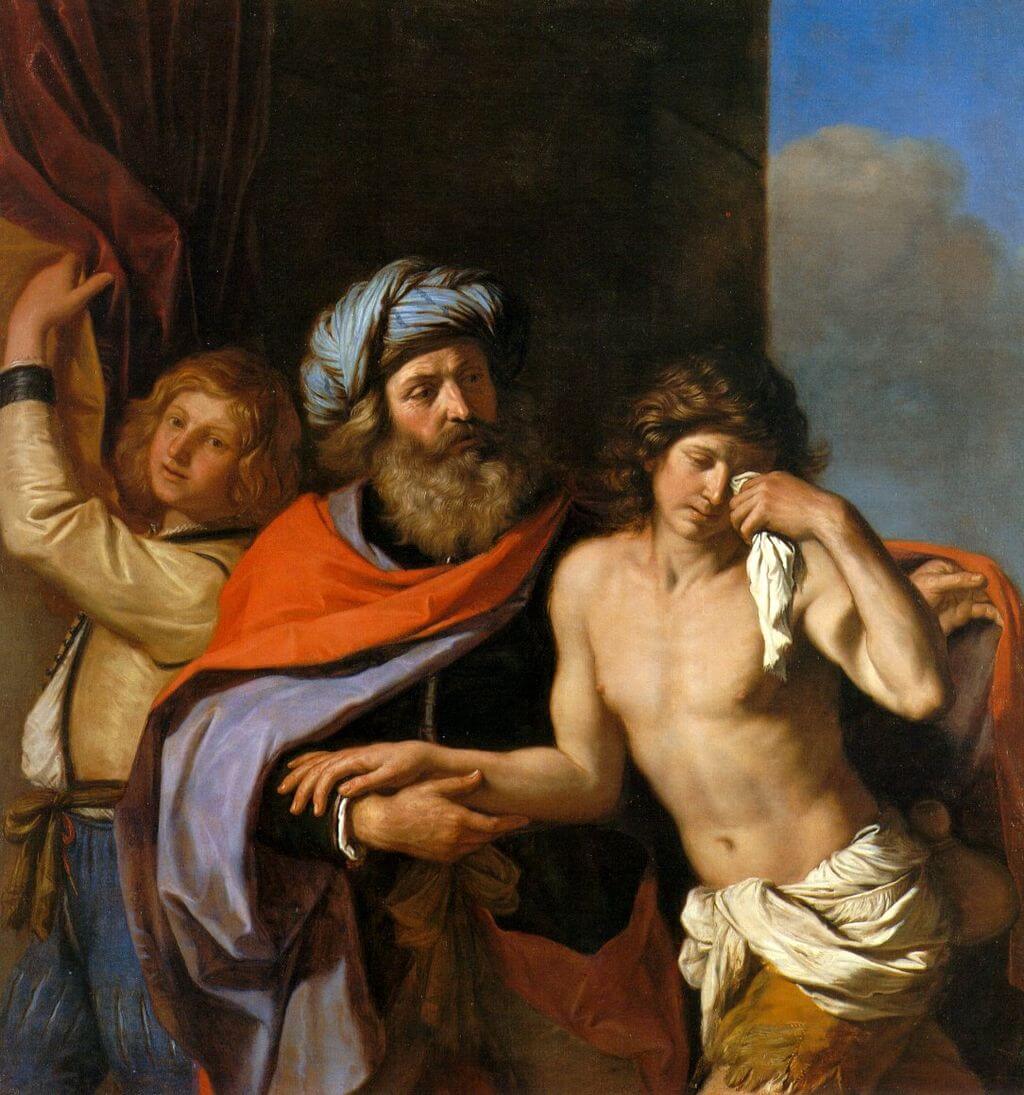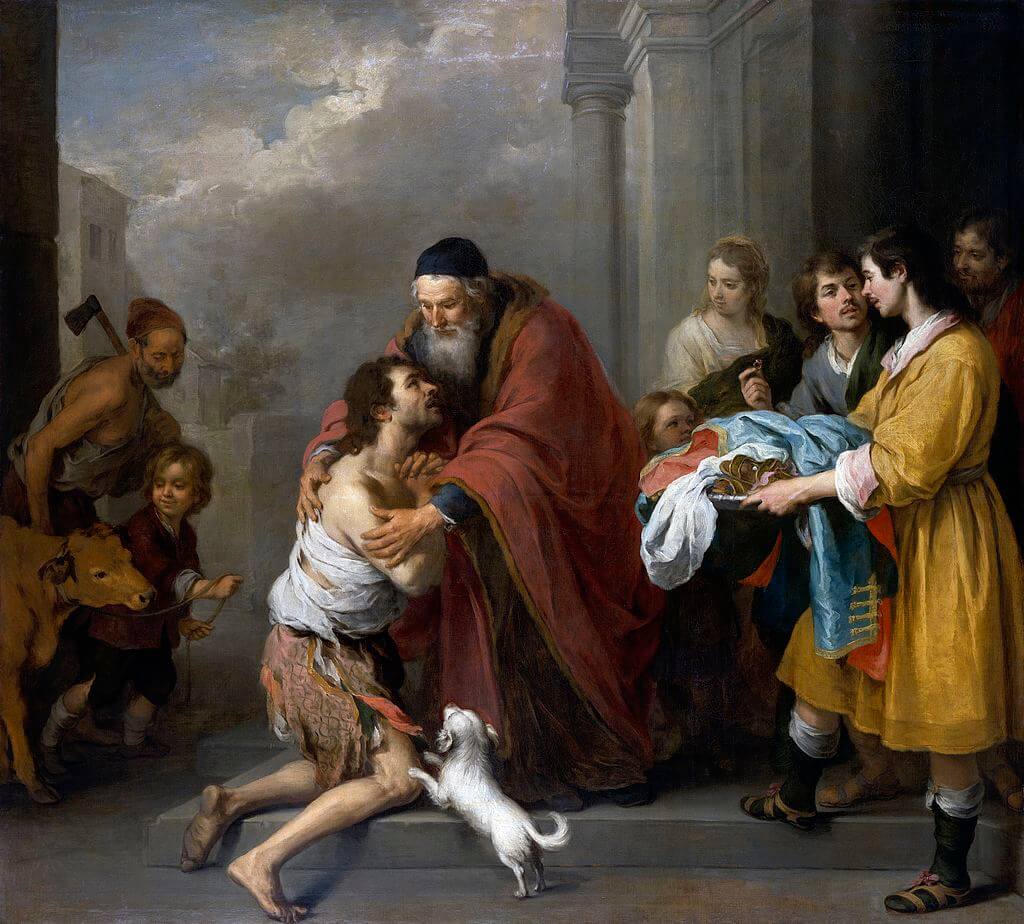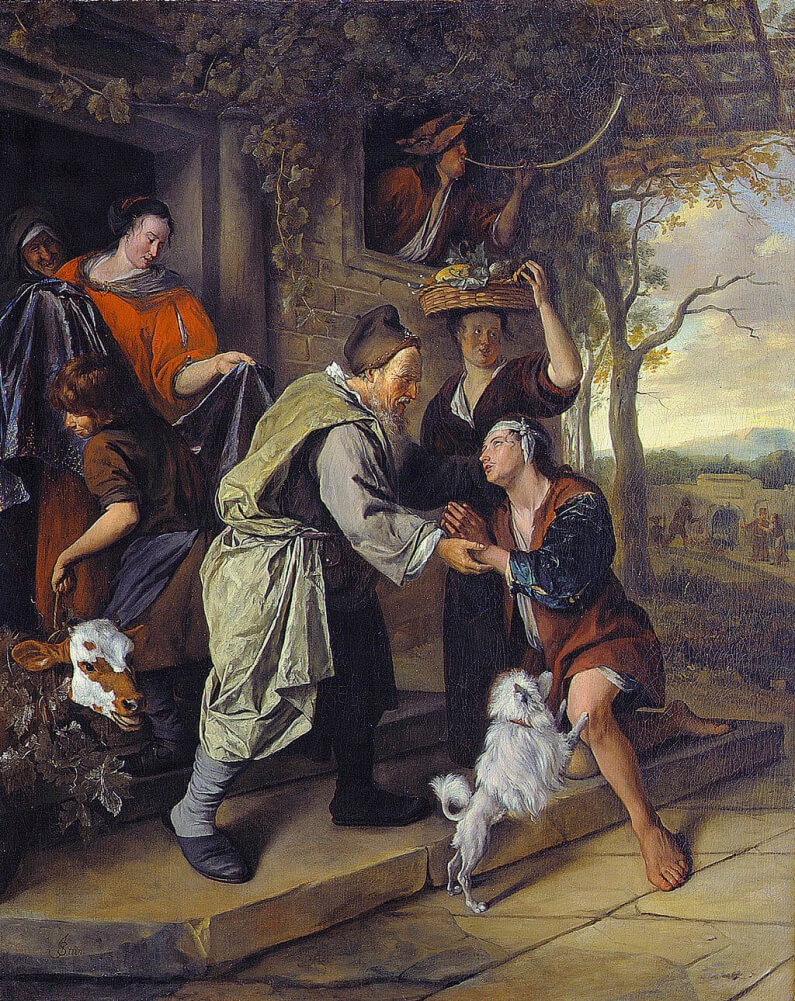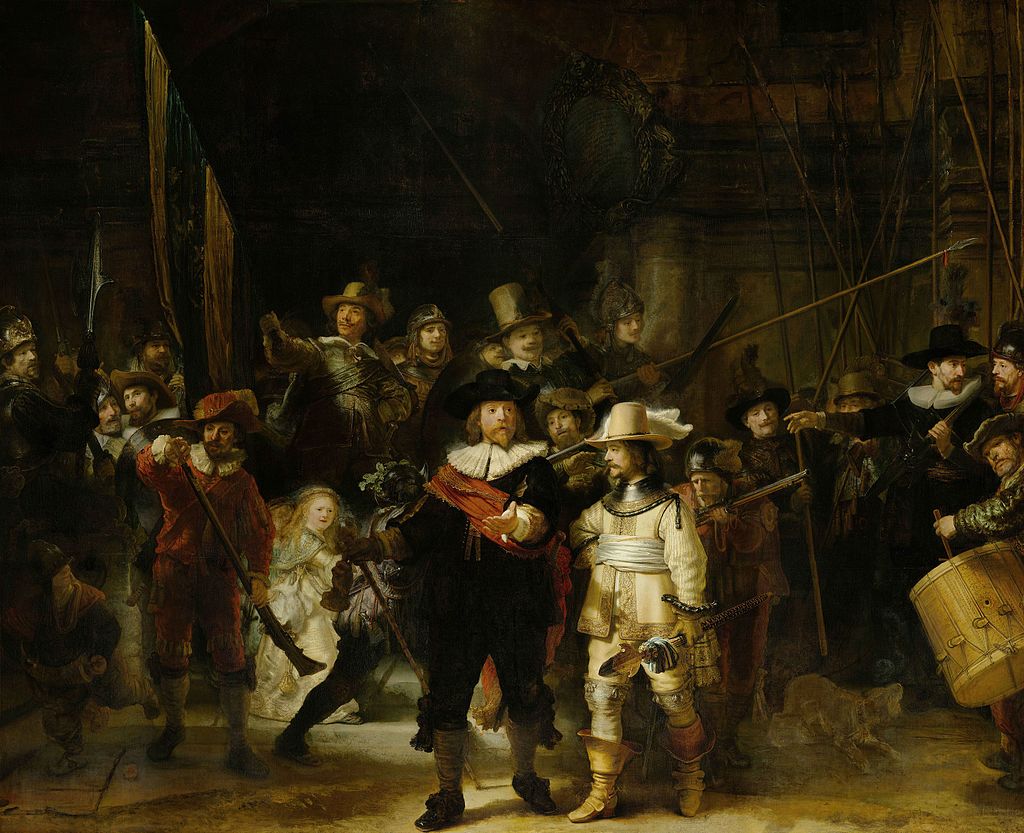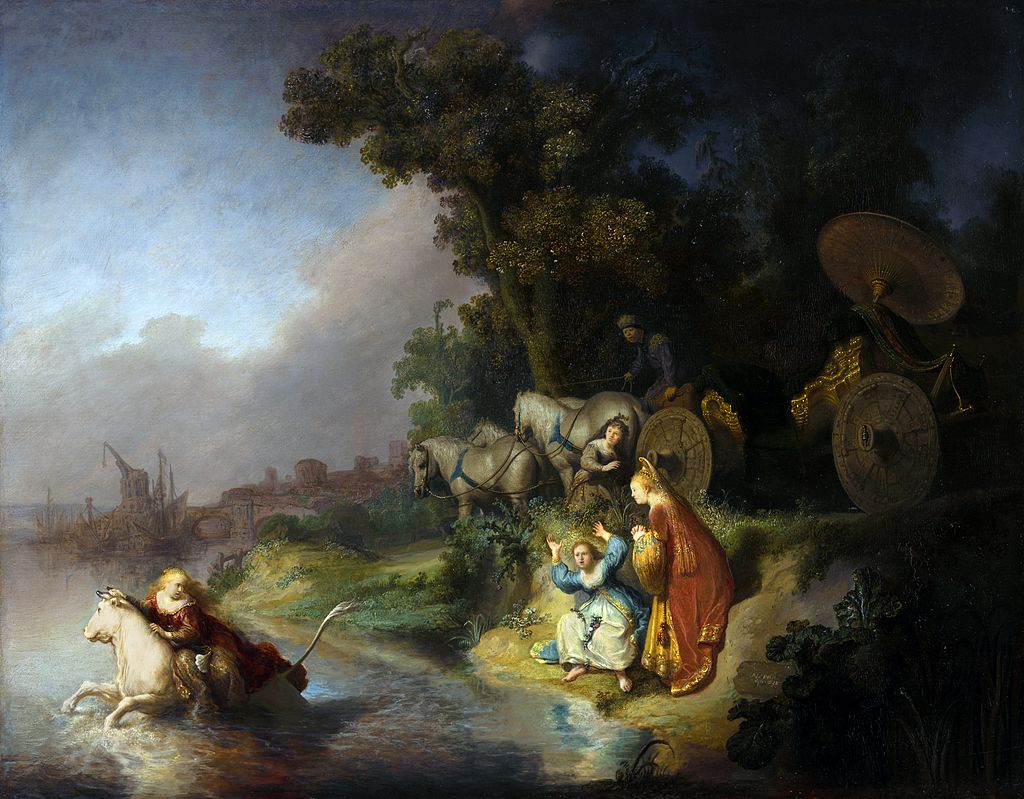|
Where? Room 254 of the New Hermitage building in the Hermitage Museum
When? 1668-1669 What do you see? Six(!) people in front of an arched doorway. On the left, an old man lovingly embraces a young and bold man who bows his head in humility. This is his son who returned home after a long time. While the father is dressed in beautiful clothes, the son is not. He wears old clothes with holes in it, and his sandals are worn and broken. He still wears the dagger on his belt that he needed to defend himself in the outside world. On the right, at a little distance, is the older son of the old man. Dressed in a red cloak, he has his hands folded while holding a cane. He looks at his younger brother with a mix of disapproval and envy. It is not certain who the other three people in this painting are. The woman in the middle background may be a sister or the mother of the prodigal son. The seated man with a mustache may be an older servant. On the top left, barely visible, is the silhouette of a female servant. Rembrandt uses light to emphasize the important aspects of the painting. The father and son are fully in the light, the older son is partially in the light, and the other people are in the darkness.
Rembrandt is able to include multiple emotions at once in this painting, which is different from some earlier work that he did on this subject as illustrated in the two pictures below. The first picture is an etching from 1636 and the second one a drawing from 1642.
The parable of the prodigal son: Luke 15: 11-32 describes a story that Jesus told to the Pharisees about a rich man and his two sons. The parable symbolizes the Christian ideal of mercy. It relates to Luke 15:7, where Jesus says that there is more joy in Heaven over one sinner who regrets his sins than over 99 good people who need no change.
The parable describes that the younger of two sons asked his father for his share of the inheritance and left the house. He wasted his money and lived like a fool until he ran out of money. One day, he realized how foolish he has been and decided to return home to his father and beg him for forgiveness. The father was very happy to get his son back and organized a big party. The older son, however, is not so happy. While his younger brother was wasting his money and feasted with prostitutes, he continued to work hard for his father’s business, and he had never gotten such a big party. The father told the older son that everything he has is also owned by him, but that on this day he celebrates the life of his youngest son. Backstory: This is the last major painting Rembrandt painted during his life, and it is probably the best-known of his religious works. The painting combines two elements from the Biblical story. The meeting between the father and the younger son, and the separate meeting between the father and the older son. According to Luke 15, the older brother is not present when the father is reunited with his youngest son. However, just like in the parable that Jesus told, it is not clear in this painting whether the oldest son will walk away from his younger son or will eventually welcome him back as well. Moral message: Rembrandt did not use any clear symbols to convey the main message of this painting. He just shows the emotions of the father and the two sons, which include some important Biblical lessons. The father shows what mercy is, a reference to how God forgives sinners who ask for forgiveness. And the younger son shows that you can always ask God for forgiveness for your mistakes. And the older son? He personifies the person who did not make many mistakes yet and followed God. But he also struggles with the idea that God is willing to forgive the mistakes of sinners. In this painting, we can see him struggle with the attitudes of his father and brother, and whether he put his jealousy aside and forgive his younger brother. The Prodigal Son by other artists: To better understand what makes this painting by Rembrandt so special, it is helpful to compare Rembrandt’s version with those of some well-known colleagues of him.
Who is Rembrandt? Rembrandt Harmenszoon van Rijn (1606-1669) was a very talented painter from The Netherlands. He is considered as one of the most influential Baroque painters. Rembrandt had an eventful life in which he experienced many extreme situations of prosperity and adversity. Earlier in his career he was financially very successful, happily married, and got children. However, soon after, three of his children died in childhood, his wife died at age 32, and he faced financial difficulties.
As illustrated by the current painting, Rembrandt was very good in painting human emotions. He painted many realistic self-portraits during his life in which his face reflects his state of mind and the events in his life. Rembrandt’s most famous work is The Night Watch in the Rijksmuseum in Amsterdam. However, he has also painted an occasional mythological work, like The Abduction of Europa in the Getty Museum.
Fun fact: Look at the hands of the father in this painting. They are quite different. His right hand has a lighter color than the left hand. And, the fingers on the right hand are longer and thinner than those on the left hand. The right hand is feminine, and the left hand is masculine. The reason for these differences has been debated quite a bit over the years, and the main explanation is that the hands represent both the hand of the father and the mother of the prodigal son as God can assume both roles for us.
Interested in a copy for yourself? Poster or canvas
Written by Eelco Kappe
References:
10 Comments
Marga
3/24/2019 09:27:33 pm
Hi, I am just curios about the painting of the prodigal son.
Reply
TripImprover
3/25/2019 12:12:21 pm
Hi Marga,
Reply
12/23/2020 05:58:16 pm
It has given me a fresh perspective on the topic tackled. Thanks!
Reply
Lance Cross
10/22/2021 02:11:02 pm
Do any of you know what the estimated value of “The Return of the Prodigal Son” is worth?
Reply
Terri Halleck
1/17/2023 12:57:38 pm
Today is the first time look at the prodigal son. I understand the story well and the painting reflects the story. I am wondering about the dagger; and why he included it on this very broken man, other then it was his last remnant of wealth. Other theories??
Reply
TripImprover
1/18/2023 02:35:00 pm
My best understanding of the presence of the dagger is that the prodigal son went out into a dangerous world, especially when he ran out of money. And so he has a dagger to protect himself in that outside world. If you have other ideas, I am interested in hearing them!
Reply
Anna C. Maxey
2/12/2023 04:04:42 am
The cold sharp metal of his dagger was not sufficient to protect him from all the dangers of the outside world, such as poverty, drunkenness and immorality. His ultimate protection was in the refuge of his Father's warm love and forgiveness.
Terri Halleck
1/17/2023 01:00:26 pm
I forgot to click comments to my post. Thank you.
Reply
Eva
2/11/2024 06:41:39 pm
The younger son spends all his riches apart from the dagger. Even though he is starving he has not exchanged his dagger for food or anything else. The dagger represents his attachment to his father, even though he has lost everything he is still his father's son. His grief on loosing everything helps him to find some of himself again. He then returns to his father.
Reply
Eelco Kappe
2/13/2024 11:34:35 am
That is an interesting idea, thanks for sharing
Reply
Leave a Reply. |
Categories
All
|
- Home
- Blog
-
Museums
- Alte Pinakothek
- Art Institute of Chicago
- Baltimore Museum of Art
- Barber Institute of Fine Arts
- Bargello
- Barnes Foundation
- British Museum
- Church of Sant’Anastasia
- Cleveland Museum of Art
- Courtauld Institute of Art
- Detroit Institute of Arts
- Frans Hals Museum
- Galleria Borghese
- Gallerie dell'Accademia
- Getty Museum
- Guggenheim
- Hermitage Museum
- Kunsthistorisches Museum
- Kunstmuseum Basel
- Legion of Honor Museum
- Louvre
- Mauritshuis
- Metropolitan Museum of Art
- Musee d’Orsay
- Museum of Fine Arts in Boston
- Museum of Modern Art
- National Gallery in London
- National Gallery of Art
- National Museum in Poznań
- Norton Simon Museum
- Ny Carlsberg Glyptotek
- Palace of Versailles
- Palazzo Pitti
- Palazzo Vecchio
- Petit Palais
- Philadelphia Museum of Art
- Prado
- Pushkin Museum
- Ravenna Art Museum
- Rijksmuseum
- San Diego Museum of Art
- Santa Maria delle Grazie
- St. Peter's Basilica
- Städel Museum
- Statens Museum for Kunst
- Tate Britain
- Tate Modern
- Timken Museum of Art
- Uffizi
- Vatican Museums
- Wallace Collection
-
Artists
- Altdorfer
- Anguissola
- Berlin Painter
- Bosch
- Botticelli
- Boucher
- Bronzino
- Bruegel the Elder
- Brunelleschi
- Cabanel
- Caillebotte
- Canova
- Caravaggio
- Carpeaux
- Cezanne
- Cimabue
- David
- Degas
- Delacroix
- De Maria
- Donatello
- El Greco
- Fontana
- Fra Angelico
- Fragonard
- Gauguin
- Gentileschi
- Gericault
- Gonzalez-Torres
- Goya
- Hals
- Hogarth
- Hokusai
- Ingres
- Leonardo da Vinci
- Lippi, Filippo
- Longhi, Barbara
- Lorrain
- Makovsky
- Manet
- Massys
- Matisse
- Merian
- Michelangelo
- Mochi
- Modigliani
- Monet
- Panini
- Parmigianino
- Perugino
- Picasso
- Pisanello
- Raphael
- Rembrandt
- Renoir
- Reynolds
- Rivera
- Rodin
- Rubens
- Scultori
- Seurat
- Steen
- Tintoretto
- Titian
- Toulouse-Lautrec
- Turner
- Uccello
- Van der Weyden
- Van Dyck
- Van Eyck
- Van Gogh
- Van Hemessen
- Vasari
- Velazquez
- Vermeer
- Veronese
- Vigée Le Brun
-
Locations
- Books
- About Us

